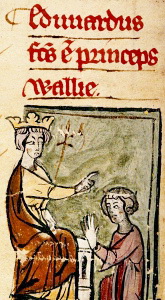Prince of Wales
Prince of Wales is a title granted to the heir apparent of the British monarchy, traditionally bestowed upon the eldest son of the reigning monarch of the United Kingdom. The title has a rich history, dating back to the 14th century, and is associated with various duties, privileges, and expectations within the British royal family and the Commonwealth realms.
History[edit | edit source]
The title "Prince of Wales" was first used by King Edward I of England in 1301, following his conquest of Wales. Edward I invested his son, the future Edward II, as the first English Prince of Wales, establishing a practice that has continued to the present day. The title is not hereditary and must be conferred by the reigning monarch. It is intended to signify the heir apparent to the throne, and its use is a matter of royal prerogative.
Role and Duties[edit | edit source]
The role of the Prince of Wales has evolved over time. Historically, the title came with responsibilities and powers, particularly in relation to the governance of Wales. However, in the modern era, the title is more ceremonial, with the Prince of Wales undertaking various public and charitable activities. The current Prince of Wales, like his predecessors, is involved in numerous charitable organizations and initiatives, focusing on issues such as environmental conservation, architecture, and social welfare.
Investiture[edit | edit source]
The investiture of the Prince of Wales is a ceremony that formally bestows the title upon the heir apparent. While not a constitutional requirement, investitures have been significant public events. The most recent investiture was that of Prince Charles in 1969, held at Caernarfon Castle in Wales. The ceremony is rich in tradition and symbolism, reflecting the historical and cultural ties between the title and Wales.
Titles and Honors[edit | edit source]
In addition to being the Prince of Wales, the heir apparent usually holds several other titles, including Duke of Cornwall, in England, and Duke of Rothesay, in Scotland. These titles are associated with different regions of the UK and reflect the historical territories of the British Crown. The Prince of Wales also typically receives the Order of the Garter, the oldest and highest order of chivalry in the United Kingdom.
Residences[edit | edit source]
The Prince of Wales has access to several official residences, including Clarence House in London, which serves as the official London residence, and Highgrove House in Gloucestershire, which is the family residence. Other properties, such as Llwynywermod in Wales, are also used by the Prince of Wales and his family.
Current Prince of Wales[edit | edit source]
As of the last update, the current Prince of Wales is Charles, Prince of Wales, the eldest son of Queen Elizabeth II. Born on November 14, 1948, he became Prince of Wales in 1958, though his investiture did not take place until 1969. He is the longest-serving Prince of Wales in British history. His work and public engagements cover a wide range of interests, including environmental sustainability, architecture, and interfaith dialogue.
Future of the Title[edit | edit source]
The title of Prince of Wales is deeply embedded in the history and tradition of the British monarchy. Its future will continue to be closely linked to the line of succession and the constitutional framework of the United Kingdom. As the monarchy evolves, the role and significance of the Prince of Wales may also change, reflecting the contemporary values and priorities of the British people.
Search WikiMD
Ad.Tired of being Overweight? Try W8MD's physician weight loss program.
Semaglutide (Ozempic / Wegovy and Tirzepatide (Mounjaro / Zepbound) available.
Advertise on WikiMD
|
WikiMD's Wellness Encyclopedia |
| Let Food Be Thy Medicine Medicine Thy Food - Hippocrates |
Translate this page: - East Asian
中文,
日本,
한국어,
South Asian
हिन्दी,
தமிழ்,
తెలుగు,
Urdu,
ಕನ್ನಡ,
Southeast Asian
Indonesian,
Vietnamese,
Thai,
မြန်မာဘာသာ,
বাংলা
European
español,
Deutsch,
français,
Greek,
português do Brasil,
polski,
română,
русский,
Nederlands,
norsk,
svenska,
suomi,
Italian
Middle Eastern & African
عربى,
Turkish,
Persian,
Hebrew,
Afrikaans,
isiZulu,
Kiswahili,
Other
Bulgarian,
Hungarian,
Czech,
Swedish,
മലയാളം,
मराठी,
ਪੰਜਾਬੀ,
ગુજરાતી,
Portuguese,
Ukrainian
Medical Disclaimer: WikiMD is not a substitute for professional medical advice. The information on WikiMD is provided as an information resource only, may be incorrect, outdated or misleading, and is not to be used or relied on for any diagnostic or treatment purposes. Please consult your health care provider before making any healthcare decisions or for guidance about a specific medical condition. WikiMD expressly disclaims responsibility, and shall have no liability, for any damages, loss, injury, or liability whatsoever suffered as a result of your reliance on the information contained in this site. By visiting this site you agree to the foregoing terms and conditions, which may from time to time be changed or supplemented by WikiMD. If you do not agree to the foregoing terms and conditions, you should not enter or use this site. See full disclaimer.
Credits:Most images are courtesy of Wikimedia commons, and templates, categories Wikipedia, licensed under CC BY SA or similar.
Contributors: Prab R. Tumpati, MD





